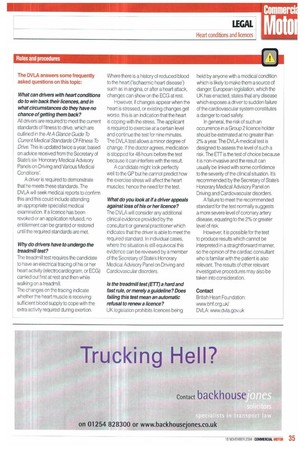Rules and procedures The DVLA answers some frequently asked questions
Page 35

If you've noticed an error in this article please click here to report it so we can fix it.
on this topic: What can drivers with heart conditions do to win back their licences, and in what circumstances do they have no chance of getting them back? All drivers are required to meet the current standards of fltness to drive, which are outlined in the At A Glance Guide To Current Medical Standards Of Fitness To Drive. This is updated twice a year, based on advice received from the Secretary of State's six 'Honorary Medical Advisory Panels on Driving and Various Medical Conditions'.
A driver is required to demonstrate that he meets these standards. The DVLA will seek medical reports to confirm this and this could include attending an appropriate specialist medical examination. If a licence has been revoked or an application refused, no entitlement can be granted or restored until the required standards are met.
Why do drivers have to undergo the treadmill test?
The treadmill test requires the candidate to have an electrical tracing of his or her heart activity (electrocardiogram, or ECG) carried out first at rest and then while walking on a treadmill.
The changes on the tracing indicate whether the heart muscle is receiving sufficient blood supply to cope with the extra activity required during exertion. Where there is a history of reduced blood to the heart ('ischaernic heart disease') such as in angina, or after a heart attack, changes can show on the ECG at rest.
However, if changes appear when the heart is stressed, or existing changes get worse. this is an indication that the heart is coping with the stress. The applicant is required to exercise at a certain level and continue the test for nine minutes. The DVLA test allows a minor degree of change. If the doctor agrees, medication is stopped for 48 hours before the test because it can interfere with the result.
A candidate might look perfectly well to the GP but he cannot predict how the exercise stress will affect the heart muscles; hence the need for the test.
What do you look at if a driver appeals against loss of his or her licence? The DVLA will consider any additional clinical evidence provided by the consultant or general practitioner which indicates that the driver is able to meet the required standard. In individual cases, where the situation is still equivocal this evidence can be reviewed by a member of the Secretary of State's Honorary Medical Advisory Panel on Driving and Cardiovascular disorders.
Is the treadmill test (ETT) a hard and fast rule, or merely a guideline? Does failing this test mean an automatic refusal to renew a licence?
UK legislation prohibits licences being held by anyone with a medical condition which is likely to make them a source of danger European legislation, which the UK has enacted, states that any disease which exposes a driver to sudden failure of the cardiovascular system constitutes a danger to road safety.
In general, the risk of such an occurrence in a Group 2 licence holder should be estimated at no greater than 2% a year. The DVLA medical test is designed to assess the level of such a risk. The E I 1 is the test of choice because it is non-invasive and the result can usually be linked with some confidence to the severity of the clinical situation. It's recommended by the Secretary of State's Honorary Medical Advisory Panel on Driving and Cardiovascular disorders.
A failure to meet the recommended standard for the test normally suggests a more severe level of coronary artery disease, equating to the 2% or greater level of risk.
However, it is possible for the test to produce results which cannot be interpreted in a straightforward manner, so the opinion of the cardiac consultant who is familiar with the patient is also relevant. The results of other relevant investigative procedures may also be taken into consideration.
Contact British Heart Foundation: vomiv.bhf.org.uW DVLA: www.dyla.gov.uk
























































































































































































